<

|
If you would like to show your appreciation for this info
please feel free to buy me a drink:
We have very little information on
the nocks used on Medieval longbows, but by an amazing stroke
of luck one of the horn nocks used on the Mary Rose bows did survive
- I know this is Tudor but its the nearest we have
I say a stroke of luck because they were made of horn and very
little horn survived.
Marks can be clearly seen on the Mary
Rose bow tips where the nocks had been fitted but none of the bows
had any horn nock remaining.
The single nock which was recovered was not fitted to a bow but was
found wrapped up and so protected.
If it wasn't for this single find then we would know practically
nothing about the nocks they used.
|
Why this is so important is the fact that the nocks they used turn out to
be nothing at all like the ones used today.......
It wasn't until I visited the Mary Rose and saw this nock for myself that it
really struck me just how completely different their nocks were to
anything I had seen before.
No one seemed to know anything about it, in fact it seemed that people were
just completely ignoring it, so I set about trying to find out how and why
these nocks were used. This page is basically what I have learned so
far about them and my experiences of using them on my own bows.
As far as I can tell all longbows had sidenocks until around the Victorian
era when for some reason they changed to using the more familiar modern
type. So if you want a replica medieval longbow then sidenocks are a
must.
Please feel free to send any
comments, corrections, information etc.. and I will update the page - alanesq@disroot.org
Firstly lets have a look at what I am
talking about:
click on the left picture for high
res version
As you can see, this is nothing like the nocks used on longbows now.
You can't see from these pictures but the far side of this nock is
smooth, it is a basically just a smooth horn tip with a single slot cut
down one side (hence side nock)
The slot goes right through the horn and into the wood of the bow tip (as
can
be clearly seen on the second picture) and there is a lip
on the bottom edge of the slot
Bow Tips:
This is a picture of a typical Mary Rose bow tip and you can see by the
colouration of the wood where the nock would have been and the slot in the
bow tip would have been the base of the slot in the horn nock.
My Sidenocks:
A few pictures of a nock I have made for my bow which is based on the Mary
Rose nock (this is a laminate bow, 130lb at 32")
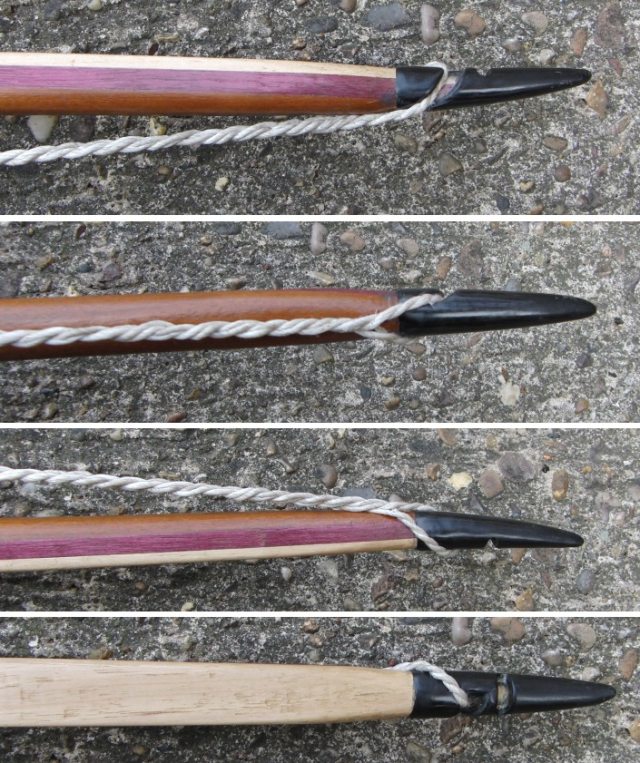
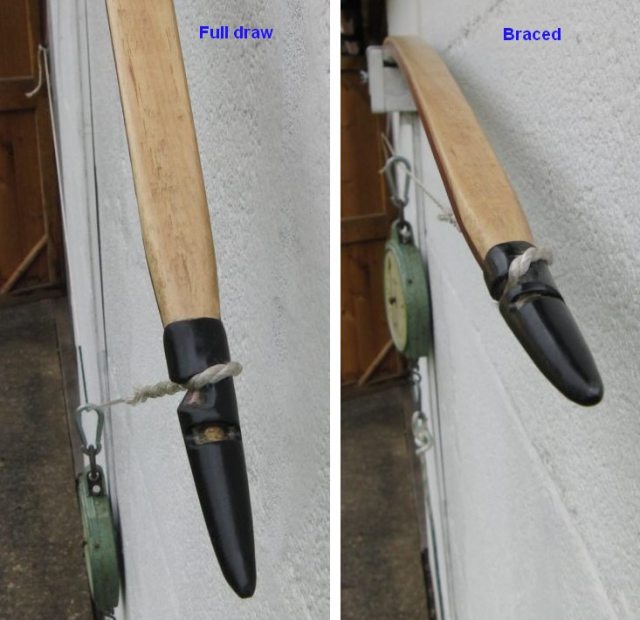
Big thanks to Lee of
Heritage-Longbows
for showing me how to use a sidenock with a loop as I had been completely
unable to figure this out, I had been using a noose on my string up to
this point although I had always strongly suspected this was wrong.
The secret to using a loop is the lip on the bottom edge of the nocks
string slot which helps holds the string in place - I had thought this was
just for when using a stringer but it turns out to be a vital feature of
the side nock
Sidenock
on my 130lb yew bow
The above is the first time I have tried a second slot for the bracer,
it works really well even with a large loop on the bracer string.
I had suspected it would get in the way of the bow string but this
is not the case at all.
BTW - This explains why a few of the Mary Rose bows have a double slot
in the bow tip.
i.e. I didn't go right through to the bow wood with the second slot but
I would imagine that sometimes if the horn is thinner then you would
This nock is made from deer antler (naturally shed so no animal
was killed to get it, but its unpleasntly smelly stuff to work - think
I will stick to plastic in future)
This is the above nock (before I cut the second slot) along
side the Mary Rose one for comparison
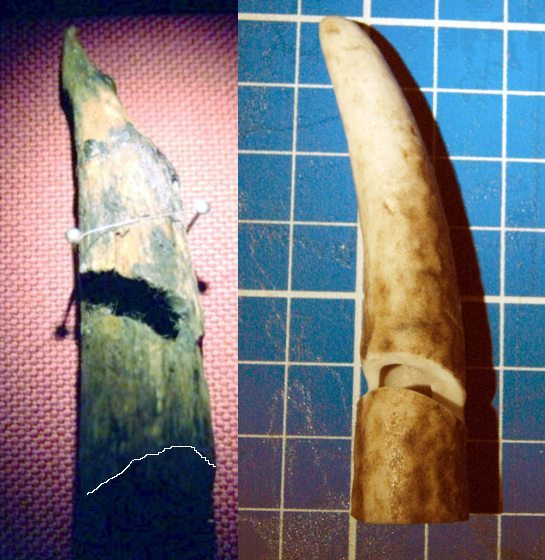
I think you can see how similar they are.
The slot is angled down slightly which results in a nice lip on
the bottom edge.
This picture shows how the bow tip sits inside the nock (red
line).
Note the mark the slot leaves in the bow tip - identical to the
Mary Rose bows
The bow tip should really go as far as the Green circle (i.e.
40mm)
I could have then put the slot a little higher up the nock |
 |
The bow tip should be approx 12.5mm wide 40mm
in from the tip
(base of the nock) and the nock should be
around 15mm at its widest
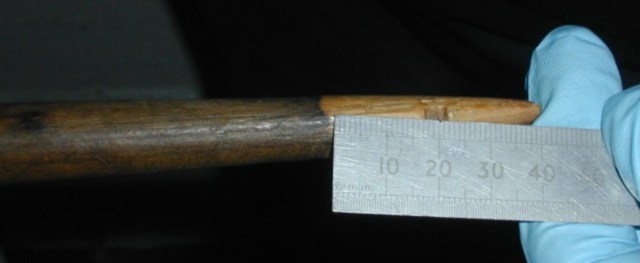
 Above pictures c/o Steve Stratton
Above pictures c/o Steve Stratton
I have received a copy of the archaeology diagram from the Mary
Rose Trust, this gives accurate dimensions of the nock (i.e. 15mm wide
and 65mm long)
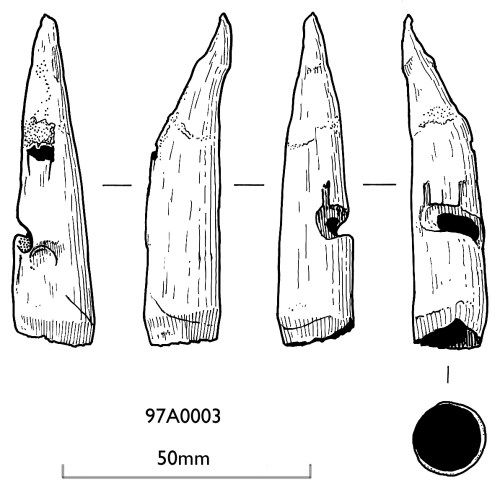
click on image for larger version
I happened to have some naturally shed
antler tips which were given to me some time ago and when you look at
one of these next to one of my nocks I think you will agree its
pretty conclusive that the nocks were just the end sawn off a horn
or antler, drilled, stuck on the bow tip and a slot cut down one side -
simple !
(well, maybe smoothed a bit as
well in this case)
Misc:
The obvious question when you see a sidenock is why were they used.
This is a question I have pondered a lot and I can't give a simple answer, I
suspect that the real question should be why have we recently converted from
sidenocks to the ones we use now? I would guess the answer to this is
likely to be that we are using different string materials and mostly much
lighter bows.
One thing which I think may be significant is the way the slot goes right
through the nock into the wood of the bow tip - I wonder if the a reason for
doing this is so that the string actually holds the nock in place so if the
glue fails then the nock will still work. I have tried using a bow
with the nock not glued on like this and it does work ok. I have been
informed that glues of the time would be very strong but not water proof.
I have heard it suggested that sidenocks prevent the bow twisting but I
don't know if there is any truth in this idea but with sidenocks the string
does tend to sit to one side of the bow tip resulting in the bow string
going diagonally along the bow - maybe this is significant ?
Now I am using them with a loop I find they are very easy to string and the
nocks are very easy to make - so maybe the answer is simply they are the
easiest and most reliable way to make a nock?
Whatever the reason the fact is that if you
want an authentic Medieval/Tudor copy longbow then sidenocks are the only
option
I don't know why but sidenocks seem to have been almost completely ignored
by modern longbow archers - It is now very slowly starting to be taken
up, but still it is extremely rare to see anyone using sidenocks, even when
they claim to be using a replica Mary Rose bow?
I know a few people have experimented with them and I know of three other
people who use them on a regular basis but basically any longbow you buy
(even if based on a Mary Rose bow) will have what I call
"Victorian type" nocks. (This is not the bowyers fault, they give
the customer what they want, its up to us to start asking for them)
So I have created this page in the hope it will get people interested in the
side nock and maybe get more people using them
I have been using them on all my bows for a couple of years now (up
to 140lb at 32") and I can assure you they work very well and
there is no reason not to be using them
I predict that in a few years time it will start to seem very odd to see a
longbow with anything other than sidenocks
Erik Roth (AKA Bowtoxo)
has kindly allowed me to publish part of his manuscript which relates to the
making of mediaeval and Renaissance bow strings
click HERE to view it
Some info from Hauke Gipp
I'm a traditional archer from Holland
We have been to Portsmouth (last july) where we were invited to the Mary
Rose museum and the museum archives. I saw the only surviving horn nock
and the tips of the bows, one thing was clear to me: They used sidenocks
reenforced with horn!
I have known side nocks on longbows for several years. I have been shooting
a Hedeby (Haithabu) replica bow for some years now. The original(s) dating
from the 8th/9th century a.d. are of Viking origin. They had one side
nock carved into the yewwood of the upper limb and no nock (slot) on the
lower limb. There had been a knot to hold the string. There was a nail in
the back of the upper limb to hold the string when unstrung. The bow(s) had
an estimated drawweight of about 80 to 90 lbs and with respect to the
archaeological record of arrowheads found together with the bows, they
should be regarded as weapons of war.
In a museum very close to the place where those bows were excavated I saw
some other longbows which had been excavated some km's north in Southern
Denmark. In a peatbog close to the village of Nydam three ships and a lot of
gear and weapons were found which are regarded as a sacrifices after battles
were won. Among the weapons there were about 40 longbows, made from yew and
some of elm, of which several had a spike made of antler, bone or even iron
fixed to the top of the upper limb, which characterizes them also as weapons
of war. Those bows had sidenocks as well and I made a replica of a Nydam bow
- from Hickory :o( The archaeological finds date from 240 to 400 a.d. and
are of Germanic origin.
I think sidenocks are the first type of nock used on longbows and with bows
going heavier throughout the Middle-ages using horn provided good protection
for the tips against both, bowstrings cutting through relatively soft
yewwood and damage of the tips due to transport and battle.
The sidenocks of all three different types of longbow work well with Flemish
loops if they are tight enough. On the Viking bow replica a linen thread was
used to whip just beneath the nock to prevent the string from cutting into
the wood. I think, because of the much better quality of yew there was no
such whipping on the original bows.

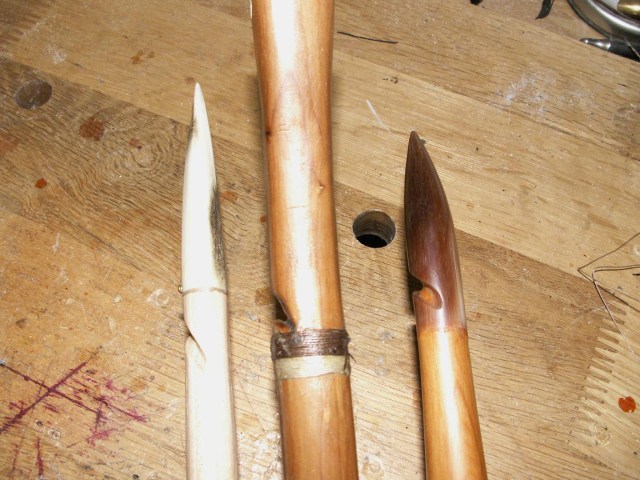
The bright coloured bow with the antlerpoint is the Nydam (it should be
Yew but this one I made from Hickory). It is about 60lb@28''. The one with
the thread binding is my old Hedeby (was 65lb@28'') and the one with
the cowhorn is the ELB I made some weeks ago (70lb@28'')
Questions still to be answered
In Roger Ascham's Toxophilus (see here) there is the following paragraph
"Great strings and little strings be for divers purposes : the great string
is more surer for the bow, more stable to prick withall, but slower for the
cast. The little string is clean contrary, not so sure, therefore to be
taken heed of, lest with long tarrying on it break your bow, more fit to
shoot far, than apt to prick near; therefore, when you know the nature of
both big and little, you must fit your bow according to the occasion of your
shooting. In stringing of your bow (though this place belong rather to the
handling than to the thing itself, yet because the thing, and the handling
of the thing, be so joined together, I must need sometimes couple the one
with the other) you must mark the fit length of your bow. For, if the string
be too short, the bending will give, and at the last slip, and so put the
bow in jeopardy. If it be long, the bending must needs be in the small of
the string, which being sore twined, must needs snap in sunder, to the
destruction of many good bows. Moreover, you must look that your bow be well
nocked, for fear the sharpness of the horn sheer asunder the string. And
that chanceth oft when in bending, the string hath but one wap to strengthen
it withal. You
must mark also to set your string straight on, or else the one end shall
writhe contrary to the other, and so break your bow. When
the string beginneth never so little to wear, trust it not, but away with
it; for it is an ill saved halfpenny, that costs a man a crown. Thus you see
how many jeopardies hangeth over the silly poor bow, by reason only of the
string. As when the string is short, when it is long, when either of the
nocks be naught, when it hath but one wap, and when it tarrieth over long
on."
The line "You must mark also to set
your string straight on, or else the one end shall writhe contrary to the
other, and so break your bow" to me suggests
that the string should not be allowed to go to one side of the bow tip.
On my nocks the string runs diagonally along the length of the bow
(i.e. the string sits to the side of the bow tips)
If this is the case then I do not know how.
Links/Pictures

The Mary Rose nock

Alabasta of Martyrdom of St Edmund-late 15c -
Picture c/o Jeremy
Spencer
Hugh Soar has kindly supplied these
pictures of a couple of bows from his collection which have sidenocks:
You can contact me on - alanesq@disroot.org
Back to my homepage
















